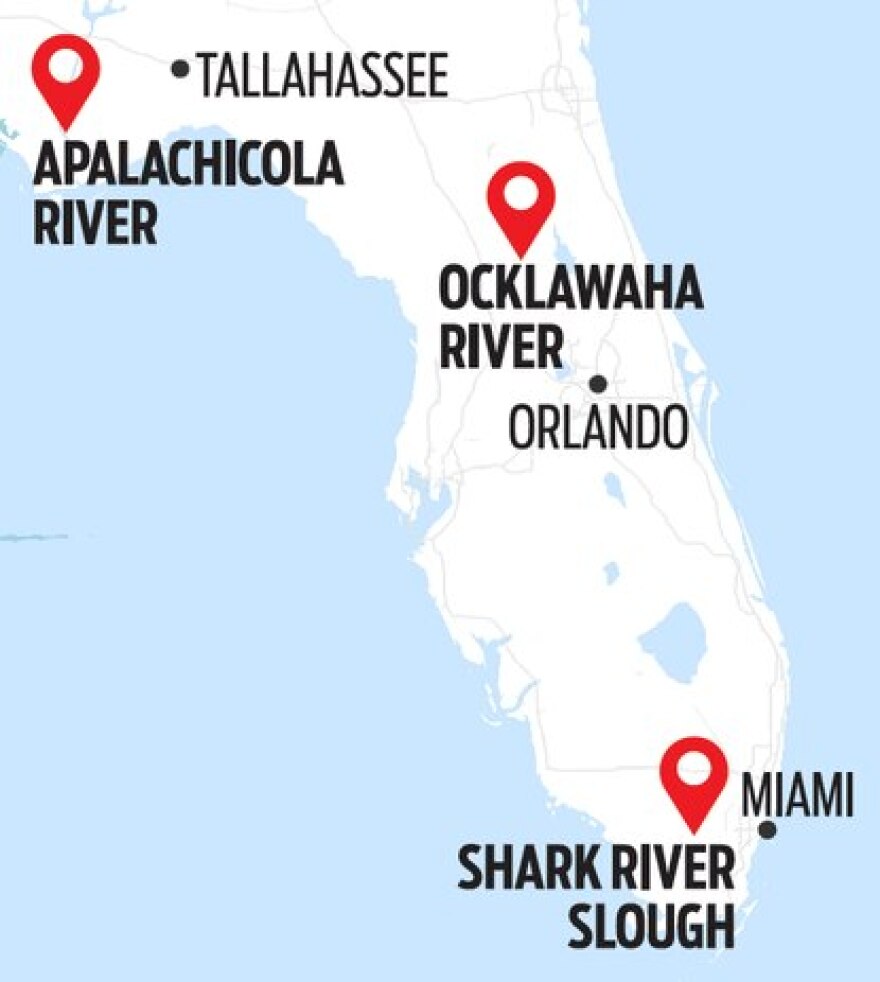Part 1 of Special Series
The Apalachicola River of North Florida in healthier times plunged deeply into tupelo forests, where the flooding waters brewed into an organic energy drink for a web of life that included a bay acclaimed for oysters.
Central Florida’s Ocklawaha River when flowing freely was a crystalline thoroughfare for a migration of fish, manatees and other wildlife from the Atlantic to the world’s largest treasure of its kind, Silver Springs.
South Florida’s Shark River Slough, a wetland mimicking a river, was enabled by nature to deliver water generously, discreetly and pristinely to the sawgrass, marsh, wading birds, alligators and more of the Everglades.
As world-renowned gems and epitomizing the natural landscapes of their Florida regions, the Apalachicola, Ocklawaha and Shark River Slough have been plundered of their natural abilities for the sake of shipping, farming and real estate. Their waters no longer are healthy, flowing freely or generous.

Florida’s environment is rife with victims and none are more tragic or contested than the two rivers and slough. Storied efforts to reverse their injuries have been piecemeal-to-paltry, or dead in the water.
But an hourglass has tipped. The coup de grace for the impaired treasures looms with climate change and assaults of rising sea levels, hotter weather, more intense storms and punishing cycles of droughts and deluges.
Climate change is expected to resemble COVID by inflicting its worst on those with preexisting health conditions.
“Preservation and restoration of the Apalachicola River, Ocklawaha River and Shark River Slough are critical to the preservation of Florida,” said Bob Graham, who served for 38 years as a Florida U.S. senator, governor and state legislator. “Climate change has caused new assaults on the health of Florida’s water. As a result, time is running out to save them.”

Protecting cities from climate change can seem torturous, calling for beefier sea walls, elevated pumps, relocating utilities, overhauling sewers, abandoning some areas and hoisting roads and buildings to drier ground along thousands of miles of vulnerable waterfronts.
Protecting nature from climate change calls simply for giving back nature’s original strengths and abilities to withstand the beatings of no rain or too much rain, searing temperatures and invading oceans.
For Florida rivers, that means getting the water right: the volume, timing and cleanliness.
“We are fighting water with water,” said Eric Stabenau, an Everglades National Park scientist, describing a central motive for restoring Shark River Slough that also applies to the Apalachicola and Ocklawaha.
Restoring natural flows of fresh water in the rivers and slough would hold back the harmful rise of salty seawater.

“Fresh against salt,” Stabenau said. “It’s one of our only tools.”
The Apalachicola delivers current from as far as Appalachian snowmelt. The Ocklawaha is an expression of the Floridan Aquifer. Shark River Slough carries pristine waters clarified by dissolving limestone.
But, to be clear, the two rivers and slough are more than defined channels. They are torsos for appendages of headwaters, springs, floodplains, tributaries and coastal estuaries.
As such, the deliberate wounding of the Apalachicola’s channel prevents wetlands from enriching river water that ultimately flows to Apalachicola Bay.
The damming of the the Ocklawaha a half-century ago sabotages river water flowing to the St. Johns River as widens into estuary at the Atlantic.
The historic Tamiami Trail highway’s obstructing Shark River Slough prevents the broad, shallow migration of water that should bleed into the park and beyond -- to Florida Bay.
“It comes down to an understanding of the connectedness of an ecosystem,” said Jennifer Carr, president of Florida Defenders of the Environment, a group dedicated to the Ocklawaha River.

Biologists, hydrologists, environmentalists and politicians know what to do for the two rivers and slough – it’s what Florida has done already elsewhere on a large scale with celebrated success.
Government rebuilt the disemboweled headwaters of the St. Johns River for more than $250 million and undid the channelizing of the Kissimmee River for $1 billion. Those costly reconstructions rescued wetlands, healed waters and revived wildlife.
“We can address climate change,” said William Robert Irvin, president of the American Rivers environmental group, “if we take steps to restore rivers by, for example, taking out dams, restoring the free flow and restoring natural floodplains.”

The Apalachicola, Ocklawaha and Shark River Slough troubles span many governors: Charlie Crist, Jeb Bush, Bob Graham and others.
“Restoration of the Everglades, the springs in Central and Northern Florida, the Kissimmee River restoration were top priorities,” Bush said. “And we fought in the court to protect the proper, natural flow of water into Apalachicola Bay.”
What the decades of effort have done for the Apalachicola, Ocklawaha and Shark River Slough is mixed.
The fate of the Apalach seems ensnared in legal wars of no escape. State leaders have all but ignored the Ocklawaha, river champions say, because of petty politics. The Everglades, on the other hand, is gaining velocity for what’s described as the world’s biggest environmental restoration.
With the rivers and slough scattered to far ends of the state, most people may appreciate one but have little to no sense of the other two.
Even the Apalachicola, Ocklawaha and Shark River Slough champions hardly know of each other’s toils.
But they acknowledge a commonality: deadlines for their protracted battles. Climate is changing and time to do something is slipping.
This story was produced in partnership with the Florida Climate Reporting Network, a multi-newsroom initiative founded by the Miami Herald, the South Florida Sun Sentinel, The Palm Beach Post, the Orlando Sentinel, WLRN Public Media and the Tampa Bay Times.




